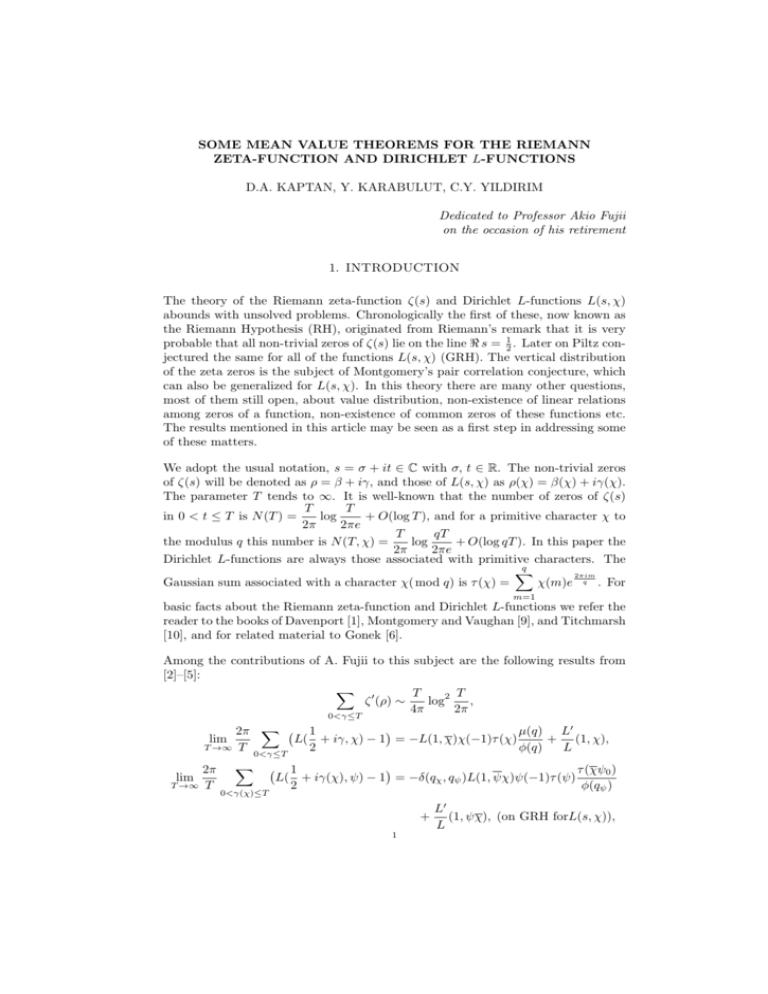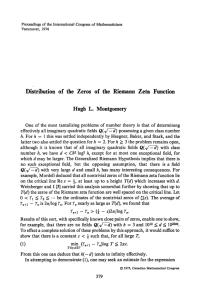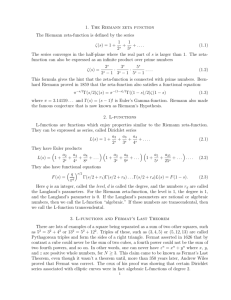SOME MEAN VALUE THEOREMS FOR THE RIEMANN ZETA
advertisement

SOME MEAN VALUE THEOREMS FOR THE RIEMANN ZETA-FUNCTION AND DIRICHLET L-FUNCTIONS D.A. KAPTAN, Y. KARABULUT, C.Y. YILDIRIM Dedicated to Professor Akio Fujii on the occasion of his retirement 1. INTRODUCTION The theory of the Riemann zeta-function ζ(s) and Dirichlet L-functions L(s, χ) abounds with unsolved problems. Chronologically the first of these, now known as the Riemann Hypothesis (RH), originated from Riemann’s remark that it is very probable that all non-trivial zeros of ζ(s) lie on the line < s = 12 . Later on Piltz conjectured the same for all of the functions L(s, χ) (GRH). The vertical distribution of the zeta zeros is the subject of Montgomery’s pair correlation conjecture, which can also be generalized for L(s, χ). In this theory there are many other questions, most of them still open, about value distribution, non-existence of linear relations among zeros of a function, non-existence of common zeros of these functions etc. The results mentioned in this article may be seen as a first step in addressing some of these matters. We adopt the usual notation, s = σ + it ∈ C with σ, t ∈ R. The non-trivial zeros of ζ(s) will be denoted as ρ = β + iγ, and those of L(s, χ) as ρ(χ) = β(χ) + iγ(χ). The parameter T tends to ∞. It is well-known that the number of zeros of ζ(s) T T in 0 < t ≤ T is N (T ) = log + O(log T ), and for a primitive character χ to 2π 2πe qT T log + O(log qT ). In this paper the the modulus q this number is N (T, χ) = 2π 2πe Dirichlet L-functions are always those associated with primitive characters. The q X 2πim Gaussian sum associated with a character χ( mod q) is τ (χ) = χ(m)e q . For m=1 basic facts about the Riemann zeta-function and Dirichlet L-functions we refer the reader to the books of Davenport [1], Montgomery and Vaughan [9], and Titchmarsh [10], and for related material to Gonek [6]. Among the contributions of A. Fujii to this subject are the following results from [2]–[5]: X T T ζ 0 (ρ) ∼ log2 , 4π 2π 0<γ≤T 2π X lim T →∞ T 0<γ≤T 2π lim T →∞ T X 0<γ(χ)≤T 1 µ(q) L0 L( + iγ, χ) − 1 = −L(1, χ)χ(−1)τ (χ) + (1, χ), 2 φ(q) L 1 τ (χψ0 ) L( + iγ(χ), ψ) − 1 = −δ(qχ , qψ )L(1, ψχ)ψ(−1)τ (ψ) 2 φ(qψ ) + 1 L0 (1, ψχ), (on GRH forL(s, χ)), L 2 where ψ is a primitive character to the modulus qψ ≥ 3, and χ is a primitive character to the modulus qχ ≥ 1, χ 6= ψ, ψ0 is the principal character mod qψ , and δ(qχ , qψ ) = 1 if qχ | qψ and = 0 otherwise. For the first formula here, Fujii also gave the secondary terms and the error term both unconditionally and conditionally on γ RH. In fact, Fujii proved more general versions and variations (involving 12 + i K where K is an integer ≥ 2 and with certain weight functions in the summands) of these formulas. 2. STATEMENT OF RESULTS The results announced here are generalizations of the above quoted results of Fujii, and are all unconditional. For mean values over the zeros of the Riemann zeta-function we showed X T j+1 (−1)j+1 T log + Oj T logj T , (j ≥ 1), ζ (j) (ρ) = j + 1 2π 2π 0<γ≤T where ζ (j) (s) is the j-th derivative of ζ(s). Assuming RH, this reveals very clearly that there are points |s| T on the critical line, which are in particular zeros of ζ(s), at which the size of |ζ (j) (s)| is logj T . Next, for χ a primitive character mod q, 3 ≤ q ≤ (log T )A , where A can be taken to be an arbitrarily large fixed number, we have X √ L0 µ(q)χ(−1)τ (χ)L(1, χ) T (1, χ) − + OA T e−c log T , L(ρ, χ) − 1 = L φ(q) 2π 0<γ≤T and for j ≥ 1, j j µ(q)χ(−1)τ (χ) T X j! X (−1)v L(v−w) (1, χ) qT w log φ(q) 2π w=0 w! v=w (v − w)! 2π 0<γ≤T √ T L0 (j) + (1, χ) + OA,j T e−c log T , 2π L where c is a non-effective constant depending on A and j. Using the bounds X L(j) (ρ, χ) = − L(j) (1, χ) j (log q)j+1 , (j = 0, 1, 2, . . .), L0 (j) j+1 (1, χ) A,j q A , (j = 0, 1, 2, . . .), L 1 L(1, χ) A 1 , qA these results imply, for the range of q specified as above, the simpler forms log log T X T T L(ρ, χ) = log 1 + OA , 2π 2π log T 0<γ≤T i.e. the average value of L(ρ, χ) is 1; X 1 µ(q)χ(−1)τ (χ)L0 (1, χ) lim L0 (ρ, χ) = − , T →∞ N (T ) φ(q) 0<γ≤T 3 q √ , |τ (χ)| = q, L0 (1, χ) log q, the average value of log log q L0 (ρ, χ) gets closer to 0 with larger q; for j ≥ 1 we see that log log T X (−1)j+1 µ(q)χ(−1)τ (χ)L(1, χ) T T j L(j) (ρ, χ) = log 1 + OA,j φ(q) 2π 2π log T so that since φ(q) 0<γ≤T if q is square-free, and if q is not square-free then X √ T L0 (j) L(j) (ρ, χ) = (1, χ) + OA,j T e−c log T 2π L 0<γ≤T L0 (j) (1, χ) can get to 0, we can in which case since we do not know how close L only say X L(j) (ρ, χ) A,j T. 0<γ≤T For mean values over the zeros with ordinates in [0, T ] of a DirichletqL-function T , c L(s, χ) where χ is a primitive character to the modulus qχ ≤ exp c log 2π being an appropriate positive constant, the averages of ζ (µ) (s) are r X L0 T ζ(β) T β T ζ(ρχ ) − 1 = (1, χ) − 2 + O T exp − C log , L 2π β 2π 2π 0<γχ ≤T and for µ ≥ 1 i h d L0 X T · ζ (µ) (ρχ ) = ( )µ (s, χ) ds L s=1 2π 0<γχ ≤T µ µ−κ X µ X (µ − κ)! (−1)j ζ (κ) (β) T β T µ−κ−j log j+2 κ (µ − κ − j)! β 2π 2π κ=0 j=0 r T + O T exp − C log , 2π where β is the possible exceptional zero of L(s, χ) (and the terms involving it are present only if β exists), and C is some positive constant. For q satisfying q(log q)4 ≤ log T , all of the terms involving β can be absorbed into the error term. − Next, in the cases µ ≥ 1, we have for q ≤ (log T )A with any fixed A > 0, X (−1)µ+1 T qT µ+1 L(µ) (ρχ , χ) = log + O T (log T )µ+ (µ + 1) 2π 2π 0<γχ ≤T for any fixed > 0. Now let ψ be a primitive character to the modulus qψ and ψ0 denote the principal character modulo qψ . Assume that q = [qχ , qψ ] (the least common multiple) satisfies q(log q)4 ≤ log T . We have X ψ(−1)τ (ψ)τ (χψ0 )L(1, χψ) T L0 T L(ρχ , ψ) − 1 = − δ(qχ , qψ ) + (1, χψ) φ(qψ ) 2π L 2π 0<γχ ≤T 4 r + O T exp − C log qψ T . 2π For µ ≥ 1, X 0<γχ ≤T qψ T µ ψ(−1)τ (ψ)τ (χψ0 )L(1, χψ) T log φ(qψ ) 2π 2π + O T (log T )µ−1+ if qχ | qψ , L(µ) (ρχ , ψ) = − and h d iT L0 L(µ) (ρχ , ψ) =(−1)µ ( )µ s=1 (s, ψχ) ds L 2π 0<γχ ≤T r qψ T if qχ - qψ . + O T exp − C log 2π X 3. REMARKS ABOUT THE PROOFS The basic idea of the proofs is to see the sums to be evaluated as a sum of residues, so we use Z X 1 g0 f (ρ̃) = f (s) (s) ds, 2πi R g c<γ̃<T where ρ̃ with imaginary part γ̃ runs through the zeros of g, and R is the rectangle having corners at a+ic, a+iT, 1−a+iT, 1−a+ic with an appropriate c (a constant) and T (so as to avoid the poles of the integrand). Using well-known estimates for ζ(s), L(s, χ) and their derivatives, the horizontal integrals and the integral on the vertical segment with real part a can be bounded easily, and the main term is seen to come from the integral along the vertical segment with real part 1 − a. Classical techniques and results of analytic number theory such as Perron’s formula, Dirichlet’s hyperbola method, partial summation, the prime number theorem (also for arithmetic progressions), the Pólya-Vinogradov inequality are employed in the calculations. The detailed version of the proofs are in [7] and [8]. References [1] H. Davenport, Multiplicative number theory (3rd ed. revised by H.L. Montgomery), Springer, New York, 2000. [2] A. Fujii, Uniform distribution of the zeros of the Riemann zeta function and the mean value theorems of Dirichlet L-functions, Proc. Japan Acad. 63, Ser. A, (1987), 370-373. [3] A. Fujii, Zeta zeros and Dirichlet L-functions, Proc. Japan Acad. 64, Ser. A, (1988), 215-218. [4] A. Fujii, Some observations concerning the distribution of the zeros of the zeros of the zeta function (II), Comment. Math. Univ. St. Pauli 40, No. 2, (1991), 125-231. [5] A. Fujii, On a conjecture of Shanks, Proc. Japan Acad. 70, Ser. A (1994), 109-114. [6] S.M. Gonek, Mean values of the Riemann zeta-function and its derivatives, Invent. Math. 75 (1984), 123-141. [7] D.A. Kaptan, Some mean values related to Dirichlet L-functions, M.Sc. Thesis, Bog̃aziçi University, 2009, http://seyhan.library.boun.edu.tr/record=b1558882 S5 5 [8] Y. Karabulut, Some mean value problems about Dirichlet L-functions and the Riemann zetafunction, M.Sc. Thesis, Bog̃aziçi University, 2009, http://seyhan.library.boun.edu.tr/record=b1558899 S5 [9] H.L. Montgomery and R.C. Vaughan, Multiplicative number theory I. Classical theory, Cambridge University Press, 2007. [10] E.C. Titchmarsh, The theory of the Riemann zeta function, 2nd ed., revised by D.R. HeathBrown, Oxford University Press, 1986. Deniz Ali Kaptan (Kaptan Deniz@ceu-budapest.edu): Central European University Department of Mathematics and its Applications Nador u. 9, 1051 Budapest Hungary Yunus Karabulut (yunus.karabulut1@boun.edu.tr), Cem Yalçın Yıldırım (yalciny@boun.edu.tr): Department of Mathematics Bog̃aziçi University Bebek, Istanbul 34342 Turkey







